Sidemount Regulator Configuration
Sidemount diving has been steadily gaining mainstream popularity over the last decade, offering divers an attractive alternative to traditional backmount diving configurations. One of the key elements in sidemount diving is the regulator configuration, which can greatly affect the diver’s comfort, safety, and overall diving experience.
In this article, I will describe the three main sidemount regulator configuration options; long hose/short hose, double short hoses, and double long hoses, to explore the advantages and disadvantages of each configuration and when they are an appropriate choice.
Furthermore, I will also provide safety considerations to help divers make informed decisions when choosing their sidemount regulator configuration. Whether you are a seasoned sidemount diver or a beginner taking your first step into the world of sidemount diving, this article will provide you with valuable insights on sidemount regulator configuration to optimize your diving.
What are the three options for sidemount regulator configuration?
There are three distinctive sidemount regulator configurations recognized as standard within the sidemount diving community:
- Long hose (2m/7ft) + short hose (60-80cm/24-32″), aka Hogarthian sidemount
- Double short hose (2x 1m/3ft), aka Toddy style or ISE style.
- Double long hose (2x 2m/7ft)
Long Hose/Short Hose Configuration
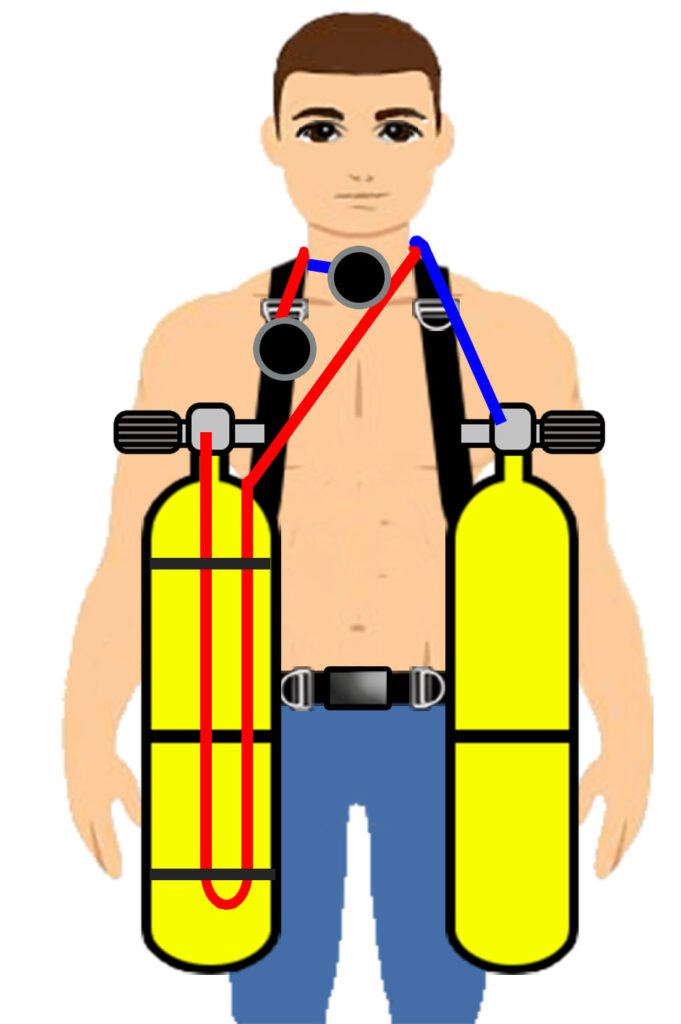
The long hose/short hose configuration is the most commonly used sidemount regulator configuration; taught in recreational, technical, and cave sidemount training. It is also the configuration that most commercial sidemount regulator sets are sold with as standard.
This configuration involves using a 2m/7ft hose for the right-side regulator and a shorter, individually custom-length, hose for the left-side primary regulator.
The long hose regulator is typically set up in a Hogartian configuration; routed upwards across the divers’ chest, anti-clockwise around their neck to feed into their mouth from the right-hand side. The long hose is clipped off to the right-side shoulder D-ring when not in use. The left-side regulator routes upwards and behind the diver’s neck where it is attached under the chin with a necklace.
Advantages and disadvantages of long hose/short hose sidemount regulator configuration
Advantages
- Possessing a long hose regulator promotes greater flexibility and increased options when dealing with foreseeable and unforeseeable emergency contingencies; especially for technical diving and within confined overhead environments like wrecks and caves.
- The necklace short hose regulator reduces the risk of entanglements, helps promotes gear streamlining, and keeps a backup regulator immediately accessible.
- This configuration is easy to set up and manage, making it a popular choice for both novice and experienced sidemount divers.
- Hogarthian long hose with short hose backup is consistent with backmount doubles configuration enabling easier conversion for existing technical divers and easy integration into mixed backmount and sidemount diving teams.
- The overwhelming majority of sidemount instructors, and training agency sidemount course syllabi, recommend and teach long hose/short hose configuration.
Disadvantages
- The long hose is clipped off to the shoulder D-ring for half of the dive, which does not enable consistent “from the mouth” donation.
- The long hose is unfamiliar to most recreational divers converting to sidemount diving.
- The long hose may also be more prone to snagging or entanglement if not properly managed and effectively secured.
- The short hose on the left-side regulator may not provide enough length for emergency gas donation.
What components are needed for a long hose/short hose sidemount regulator configuration?
The following equipment is common when configuring Hogarthian-style sidemount regulators:
- Two regulator first-stages, with swivel turret and 5th (end) port
- Two regulator second-stages
- One 2m/7ft regulator (IP) hose
- One 28-34″ regulator (IP) hose; sized to the individual
- One 90-degree adaptor (for short hose)
- One Low-Pressure Inflator (LPI) hose; size varies
- One Low-Pressure drysuit or redundant bladder LPI hose (where necessary)
- Two SPGs
- Two 6-9″ high-pressure (HP) hoses
- Regulator necklace (bungee or surgical rubber)
- Small boltsnap for the long hose
- O-ring and a cable tie for long hose boltsnap breakaway connection
- * or a dedicated boltsnap with inbuilt break away connector
Who uses a long hose / short hose sidemount regulator configuration?
The Hogarthian-style long hose/short hose configuration is overwhelmingly the most popular regulator setup for sidemount diving. Most instructors recommend this method and long hose air-sharing is an included skill requirement in nearly every dive training agency sidemount course syllabus.
The long hose/short hose sidemount regulator configuration is effective for all levels of diving; including recreational, technical, and cave. The long hose enables swift regulator donation in confined environments and promotes less stress when conducting air-sharing ascents on open-water dives. Whilst the donation of an entire primary cylinder remains an option to divers, it is not the only option available.
The need for “from the mouth” regulator donation
Whilst the diver is not able to effect “from the mouth” regulator donation when the long hose is clipped off, that has not proven detrimental or hazardous. Tens of thousands of divers have used this configuration over decades, in every conceivable diving environment, without reporting an issue with losing “from the mouth” donations as a constant factor.
Sidemount divers trained to use a long hose/short hose configuration are taught to identify donate their long hose regulator whether it is in their mouth or clipped off. This becomes an ingrained skill very quickly with sufficient deliberate, repetitive, practice.
The one reasonable argument made to support the need for “from the mouth” regulator donation is for zero visibility scenarios; where an out-of-gas diver gas to locate and access their buddies’ long hose regulator by touch. Obviously, this consideration only has merit for advanced cave and wreck divers. In reality, having to touch-feel around your dive buddy’s body to find the regulator in their mouth is not an instantaneous event. Once grasped by desperately questing fingers, the donating diver has time in which to locate and deliver their long hose. It is easy to formulate, train and ingrain far more reliable protocols for zero visibility gas donation than to simply wait, limp and apathetic, whilst an out-of-gas diver flails their hands around your body searching for the life-saving regulator.
Overall, the long hose/short hose configuration is a versatile and effective regulator configuration for sidemount diving. It provides a good balance between flexibility, ease of use, and safety, making it a popular choice for divers of all levels. Effective hose management and Hogarthian gas donation are easily learned and ingrained as responses during training with a competent sidemount instructor.
Double Short Hose Configuration
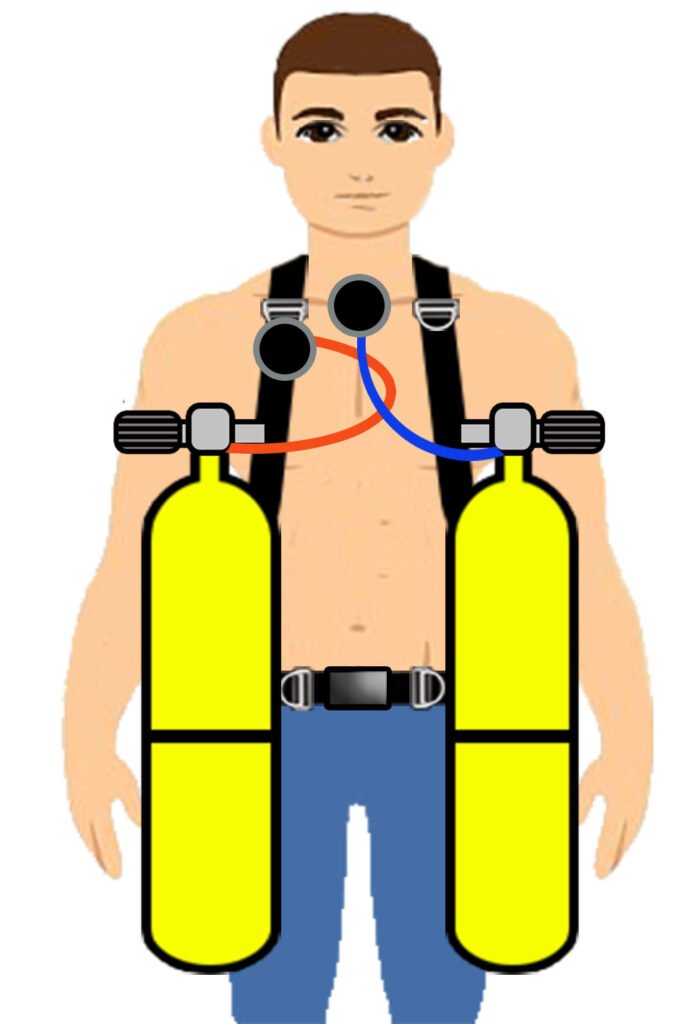
The double short hose regulator configuration for sidemount diving utilizes two shorter length hoses, typically 24-32″ in length, that route directly from the regulator to beneath the diver’s chin. The left-side regulator is typically stowed in a necklace and the right-side regulator is commonly clipped onto the necklace via a boltsnap when not in use.
Advantages and disadvantages of double short hose sidemount regulator configuration
Advantages
- Permits immediate gas donation regardless of which regulator is in the diver’s mouth.
- Does not require hose management to nearly stow the long hose on the cylinder.
Disadvantages
- Does not permit regulator donation gas sharing.
- Requires donation of the entire cylinder if an out-of-gas diver has to pass through restrictions.
- Potentially less streamlined against the torso than the Hogarthian configuration.
- Reduced flexibility in the techniques and protocols available.
What components are needed for a double short hose sidemount regulator configuration?
The following equipment is common when configuring double short hose sidemount regulators:
- Two regulator first-stages, with swivel turret and 5th (end) port
- Two regulator second-stages
- Two 1m/3ft regulator (IP) hoses
- One Low-Pressure Inflator (LPI) hose; size varies
- One Low-Pressure drysuit or redundant bladder LPI hose (where necessary)
- Two SPGs
- Two 6-9″ high-pressure (HP) hoses
- Two 90-degree regulator second-stage adapters
- Regulator necklace (bungee or surgical rubber)
- Small boltsnap for the left side hose hose
- O-ring and a cable tie for left side hose boltsnap breakaway connection
Who uses a double short hose sidemount regulator configuration?
Double short hose regulator configuration is advocated by certain DIR agencies as a means to ensure consistency of protocols across different equipment configurations; specifically the perceived need for “from the mouth” regulator donation. In general, for the vast majority of the sidemount diving community, that requirement is seen as unessential and purely dogmatic.
In addition, a handful of very high-level exploratory cave divers use double short hoses as their preferred setup. A key factor in their reasoning is that sidemount cylinders are fully independent. When diving within an exclusively sidemount team, there is a very low likelihood of a diver suffering simultaneous gas unavailability from both cylinders; thus there is little or no requirement for immediate regulator donation. A diver should retain sufficient gas reserve in either cylinder to abort the dive and return to the surface. If that reserve proves insufficient, a team member has ample time to donate an entire cylinder to the low-on-gas diver.
Safety considerations when using double short hose configuration
The main issue with the double-short hose configuration is the limitation in providing immediate regulator donation, especially within confined environments. The concept presupposes that a diver has a sufficiently robust skillset and psychological resilience to deal with sudden and unanticipated gas depletion effectively. Many sidemount divers do not have that or, at least, do not have the real-life experience to guarantee efficient and correct responses under sudden stress. It is not uncommon for divers to become panicked and flustered when unexpectedly deprived of breathing gas.
The concept of double short hose configuration also presupposes that it is unlikely that both regulators would fail to deliver gas simultaneously. However, I know of accounts where a diver has suffered a regulator failure only to switch to the alternative regulator and find that had become obstructed with silt or had shifted to an inaccessible location.
I have also had to conduct a real-life air-sharing rescue for a (backmount) technical diver who suffered a simultaneous gas delivery failure on both of their regulators. If that had happened in a confined environment using a double short hose sidemount regulator configuration it is likely that the diver would have perished. Over decades of advanced sidemount diving, I have learned to never presuppose that bad things cannot happen; regardless of likelihood.
My recommendation on double short hose sidemount regulator configuration
I do not recommend double short hose sidemount regulator configurations for less experienced divers. Nor do I recommend adopting this specialist configuration unless it is taught effectively by a sidemount instructor/agency expert in its use; and in conjunction with the appropriate skill set and protocols to accompany it.
Less experienced divers should not seek to mimic the specialist configurations or protocols sometimes adopted by elite-level divers. Whilst there seems to be a compelling logic in assuming that a diving role model must use the best possible equipment solution, it is frequently a case that their solution is specific to highly specialist needs. Those needs rarely align with what is optimal in more generalist circumstances; or what is best utilized by less-capable divers.
Using a double short hose sidemount regulator configuration should be dictated by either very high-level specialist diving needs, or be chosen to conform to a holistic, intensively-trained, and interdependent system of diving.
I have observed that some inexperienced sidemount divers are attracted to the double short hose regulator configuration because it appears superficially familiar to their prior experience with traditional backmount recreational dive gear. They wrongly assume that it will be easier to learn and operate. In reality, the double short hose regulator configuration is far more complex to use effectively and without increasing risk.
Double Long Hose Configuration
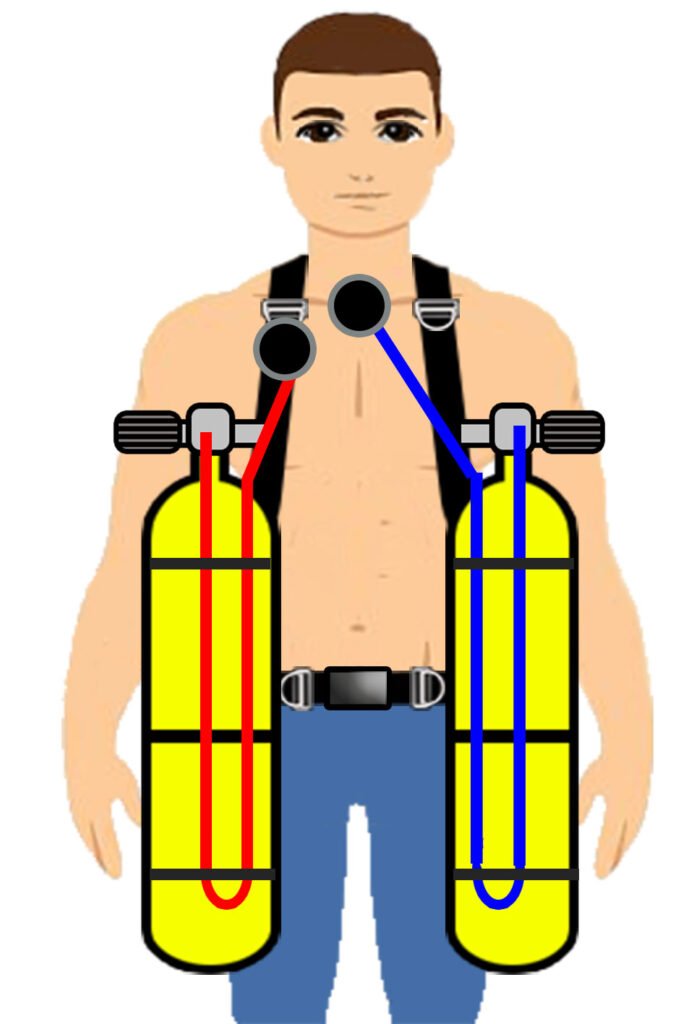
The third sidemount regulator configuration utilizes a 2m/7ft long hose from each primary cylinder. This solution attempts to address the issue of “from the mouth” donation without suffering the reduction in response flexibility of two short hoses. As with two short hoses, it is common to secure the left side regulator in a necklace and clip the right side regulator to either the necklace or shoulder D-ring via a boltsnap.
Advantages and disadvantages of double long hose sidemount regulator configuration
Advantages
- Enables “from the mouth” donation.
- Retains the flexibility of a long hose.
- Does not demand cylinder donation if passing restrictions.
- Gas from either primary cylinder can be donated.
Disadvantages
- Most complex hose management
- Easier to get hoses entangled in regulator donation
As with the double short hose sidemount regulator configuration, the primary reason for considering this solution is to preserve the protocol of “from the mouth” regulator donation. This is typically a dogmatic requirement necessary to comply with a philosophy that demands identical protocol consistency between backmount and sidemount training protocols. There is no demonstrable need for such consistency beyond adherence to specific training agency principles.
What components are needed for a double long hose sidemount regulator configuration?
The following equipment is common when configuring double long hose regulators:
- Two regulator first-stages, with swivel turret and 5th (end) port.
- Two regulator second-stages
- Two 2m/7ft regulator (IP) hoses
- One Low-Pressure Inflator (LPI) hose; size varies
- One Low-Pressure drysuit or redundant bladder LPI hose (where necessary)
- Two SPGs
- Two 6-9″ high-pressure (HP) SPG hoses
- Regulator necklace (bungee or surgical rubber) for the right side long hose
- Small boltsnap for the left side long hose
- O-ring and a cable tie for long hose boltsnap breakaway connection
My recommendation on double long hose sidemount regulator configuration
Having two long hoses superficially appears to offer the best of both worlds: long hose functionality and the ability to mouth-donate at any time. It is wrong however to only consider the merits of a solution and ignore its drawbacks. Using two long hoses demands very specific protocols to prevent the hoses from entangling each other when donated, and those protocols have to be taught with expertise and attention to detail. Complexity isn’t a good thing when it comes to emergency protocols. One has to consider whether the singular ability for continual mouth donation is worth losing the fool-proof simplicity of a Hogarthian long hose/ short hose approach. To date, the vast majority of sidemount divers and instructors, not constrained by dogmatic agency principles, have chosen simplicity and reliability.
Choosing the right sidemount regulator configuration
In conclusion, choosing the right sidemount regulator configuration is an important decision. Each configuration has its advantages and disadvantages, and divers must carefully consider their individual needs and preferences when selecting a configuration.
Whether using a long hose/short hose configuration, 2 long hoses, or 2 short hoses, proper management and training are essential for safe and enjoyable diving. By understanding the different sidemount regulator configurations and practicing proper techniques and safety considerations, divers can enhance their diving experience and explore with confidence.
Overall, I recommend that sidemount divers start off with the conventional Hogarthian-style long hose/short hose regulator configuration. Evolution into either the double long hose or double short hose configurations should occur only when your diving needs have developed to a high level of specialist sophistication; by which time you’ll be more than expert enough to know what configuration approaches will be best for you.
The exception is for divers who train with a DIR training agency that has specific principles that guide a mandated regulator configuration, but those agencies will also train divers effectively in the skills and protocols to best use that specific configuration within a compatible team.
Adding air integration (AI) to sidemount regulators
If you will be adding AI functionality to your sidemount regulator set, see my article on setting up AI transmitters for sidemount.
Similarly, if you need an air integrated computer with specialist sidemount mode capability to monitor both primary cylinders simultaneously, see my review of the Top-5 sidemount dive computers.
Are you a sidemount diver or instructor? What regulator configuration do you prefer? Share your opinions and thoughts in the comments section at the bottom of this article!
Buy my ‘Sidemount: Principles For Success’ ebook now!
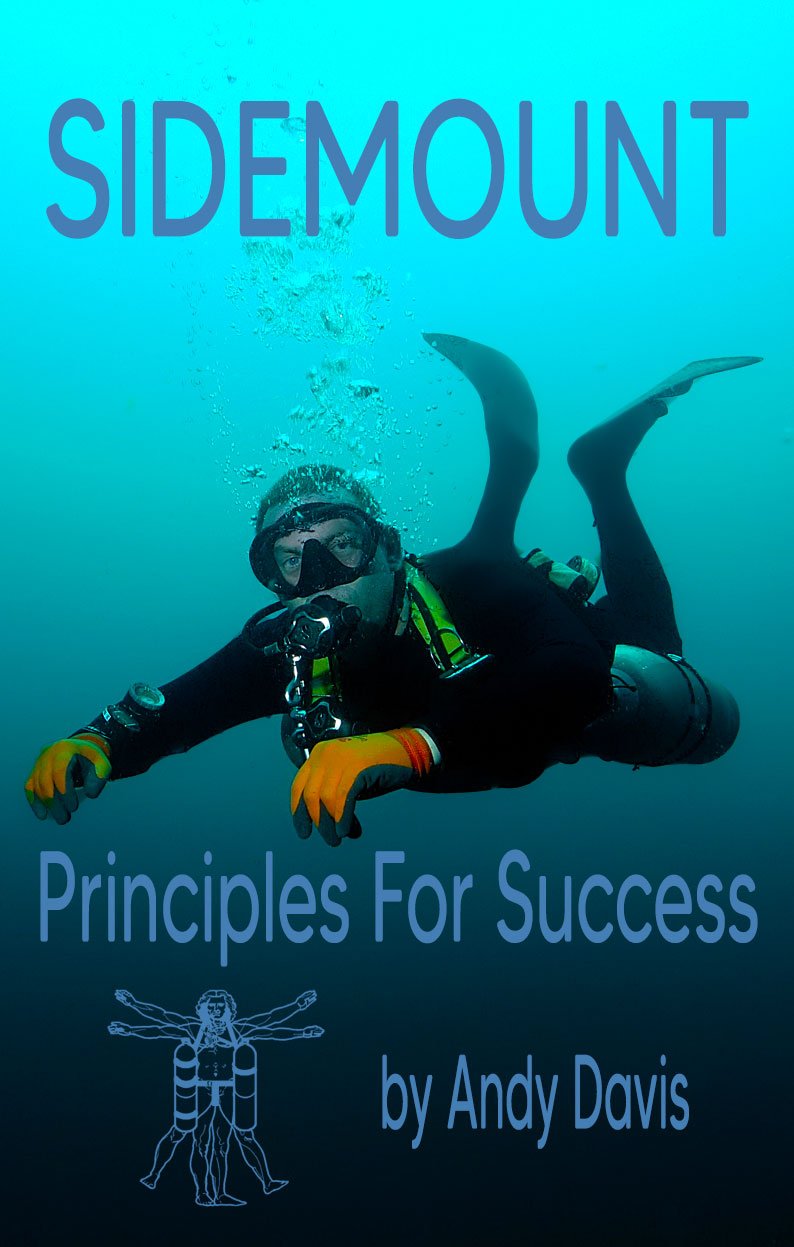
My comprehensive guide to sidemount configuration and development as a diver.
178 Pages. PDF format. Only $25
Fully Illustrated!
Chapters include:
- Sidemount history, design styles, and cylinder principles
- Harness and bungee setup and sizing
- Configuring deco/stage cylinders
- Diagnosing cylinder trim problems
- Regulators and hardware
- Training and skillset development
About The Author

Andy Davis is a RAID, PADI TecRec, ANDI, BSAC, and SSI-qualified independent technical diving instructor who specializes in teaching sidemount, trimix, and advanced wreck diving courses.
Currently residing in Subic Bay, Philippines; he has amassed more than 10,000 open-circuit and CCR dives over three decades of challenging diving across the globe.
Andy has published numerous diving magazine articles and designed advanced certification courses for several dive training agencies, He regularly tests and reviews new dive gear for scuba equipment manufacturers. Andy is currently writing a series of advanced diving books and creating a range of tech diving clothing and accessories.
Prior to becoming a professional technical diving educator in 2006, Andy was a commissioned officer in the Royal Air Force and has served in Iraq, Afghanistan, Belize, and Cyprus.
In 2023, Andy was named in the “Who’s Who of Sidemount” list by GUE InDepth Magazine.
Purchase my exclusive diving ebooks!
Sidemount regulator FAQs
Sidemount regulators typically have a swivel joint that allows for greater flexibility in hose management and an end-port (5th port) that facilitates optimized LPI hose routing across the chest.
There are two main types of regulators used in diving: balanced and unbalanced. Balanced regulators provide consistent airflow at any depth, while unbalanced regulators may experience reduced airflow at deeper depths.
Sidemount diving can be more challenging than backmount diving due to the additional equipment and techniques involved. It requires greater attention to detail and careful management of the tanks and regulators. However, with proper training and practice, sidemount diving can be a rewarding and enjoyable experience.
Sidemount diving is a type of scuba diving where the diver wears the tanks on their sides instead of on their back. This configuration allows for greater flexibility and maneuverability in tight spaces, such as underwater caves or wrecks.
Sidemount diving offers several benefits over traditional back-mounted scuba diving. It allows for greater comfort, improved buoyancy control, and easier access to valves and regulators. It also reduces strain on the back and shoulders, making it a popular choice for divers with existing injuries or physical limitations.
Originally posted 2023-02-27 20:04:48.







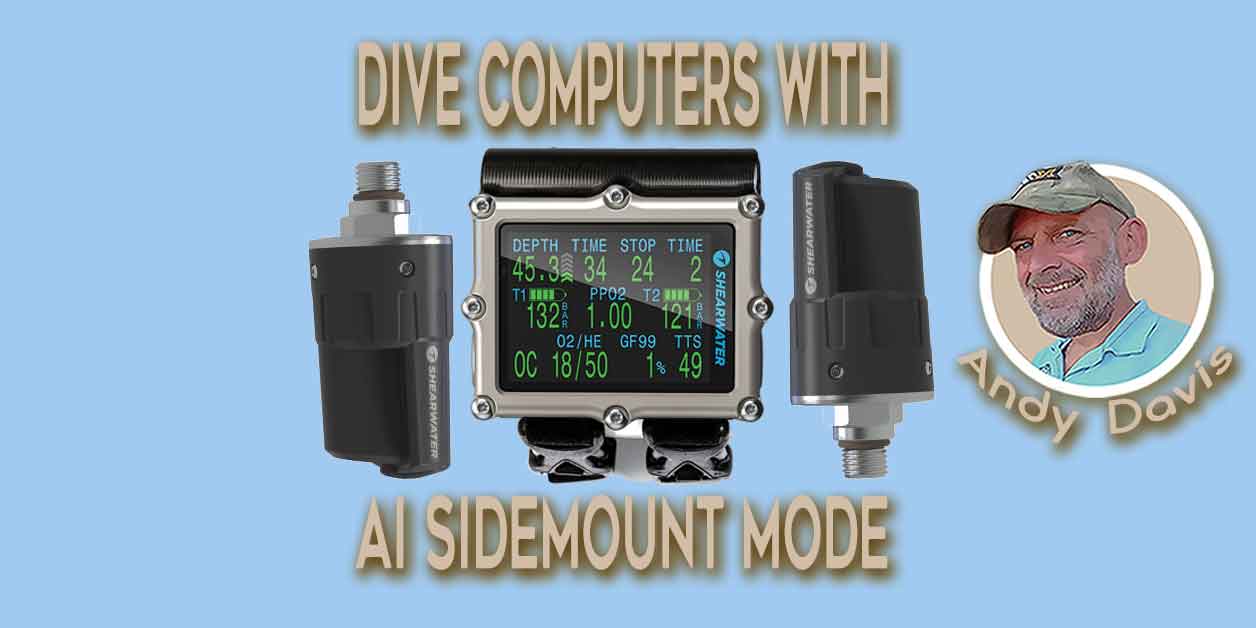
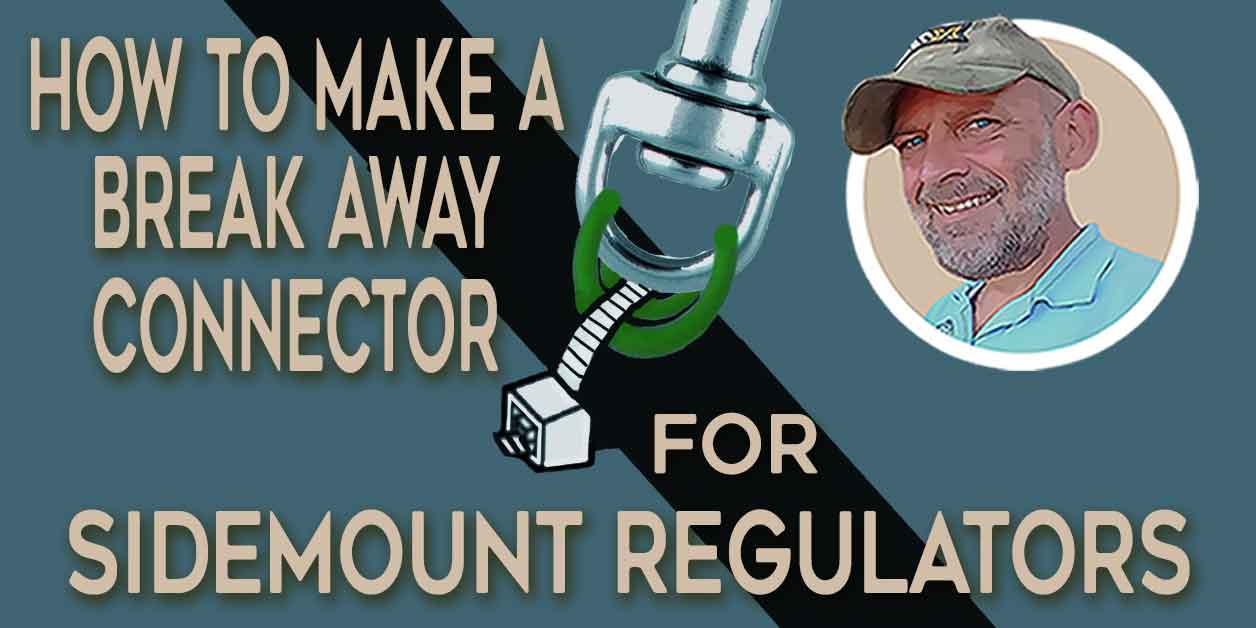
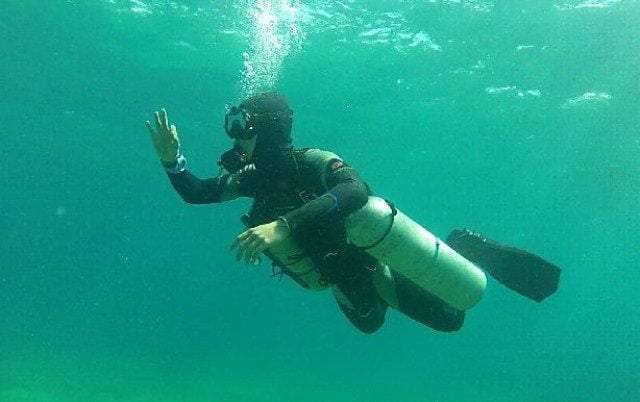
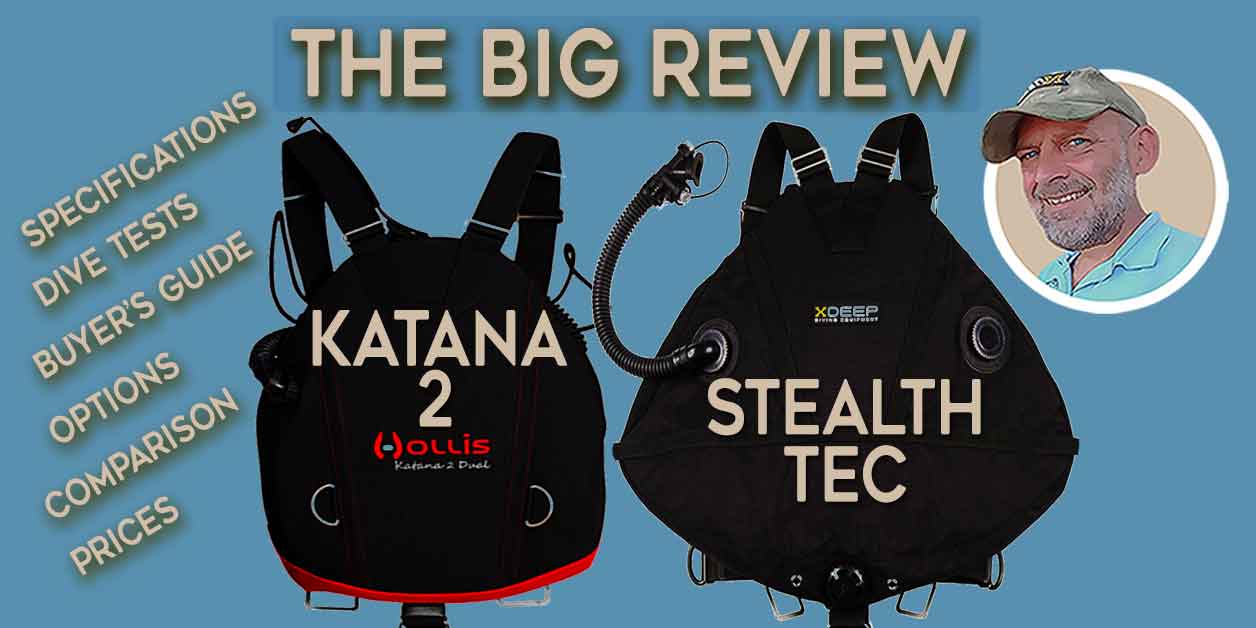
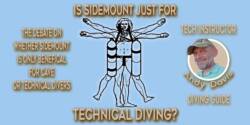
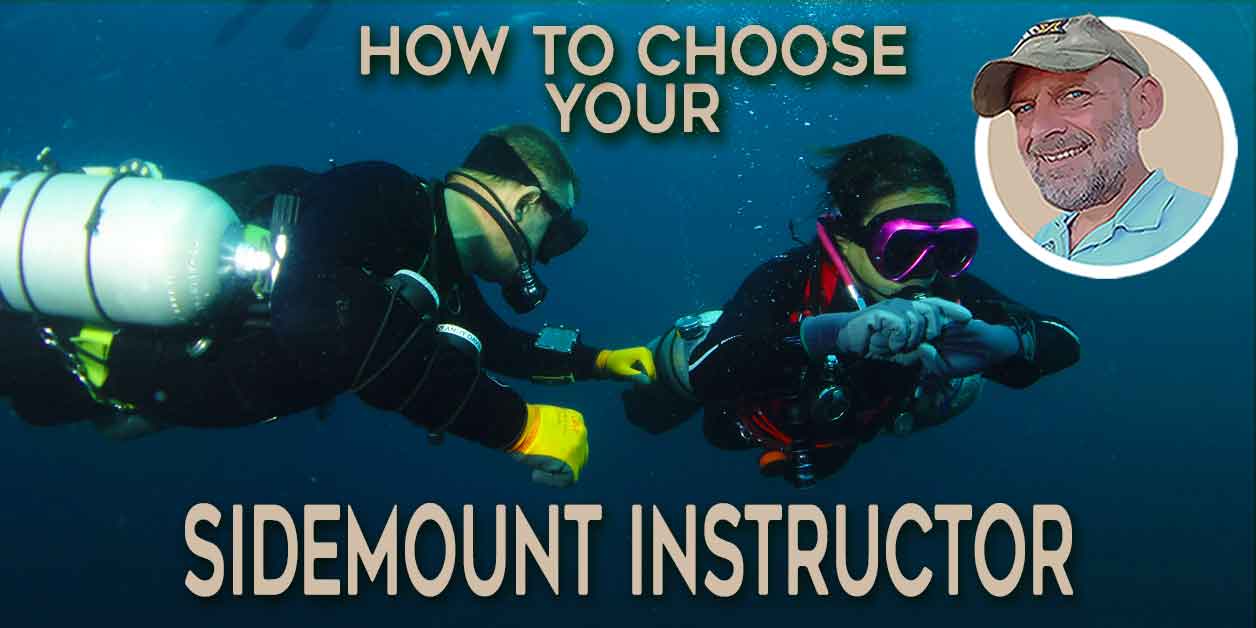
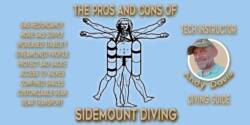
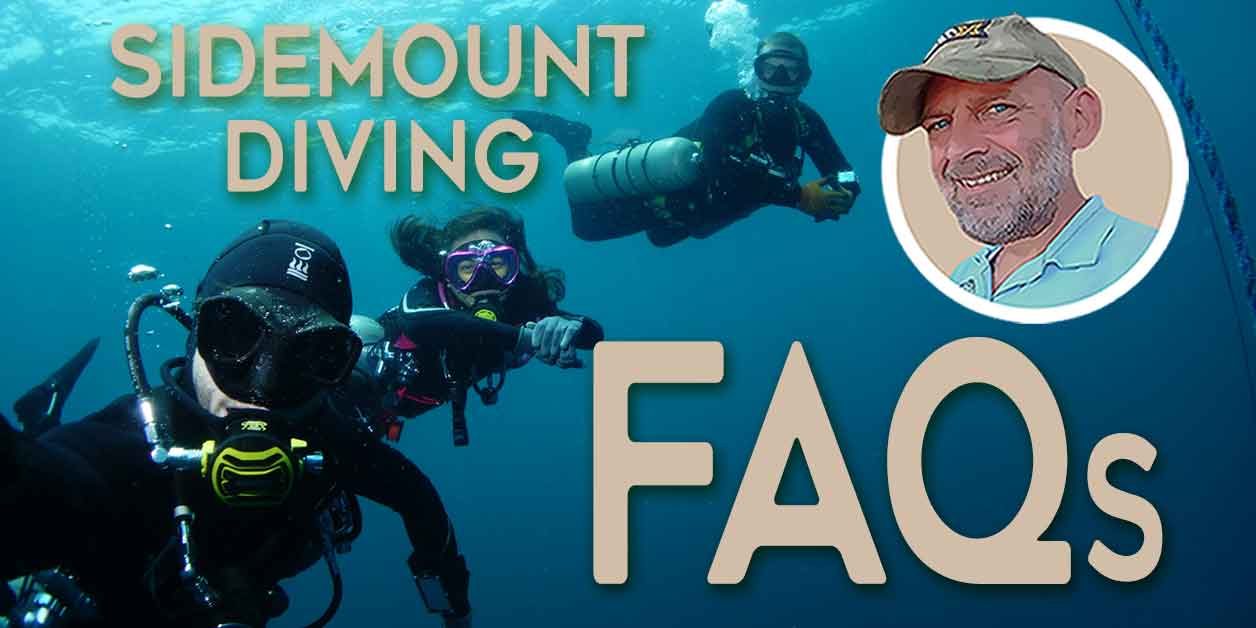
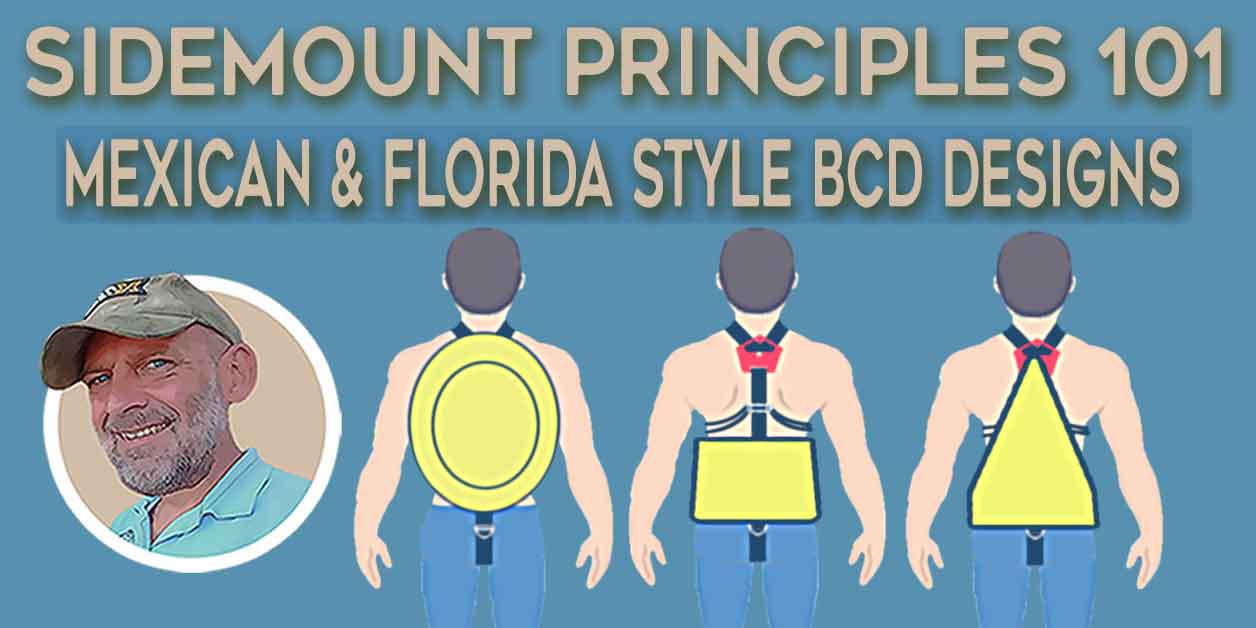
Hello Andy,
I’d like to thank you very much for the material shared in your blog and your ebooks.
I really appreciated those pieces of information.
Recently got my first dives with sidemount configuration and details you provided were really precious.
The only pity is that you are very faraway from Italy.
Have a wonderful new year,
Roberto